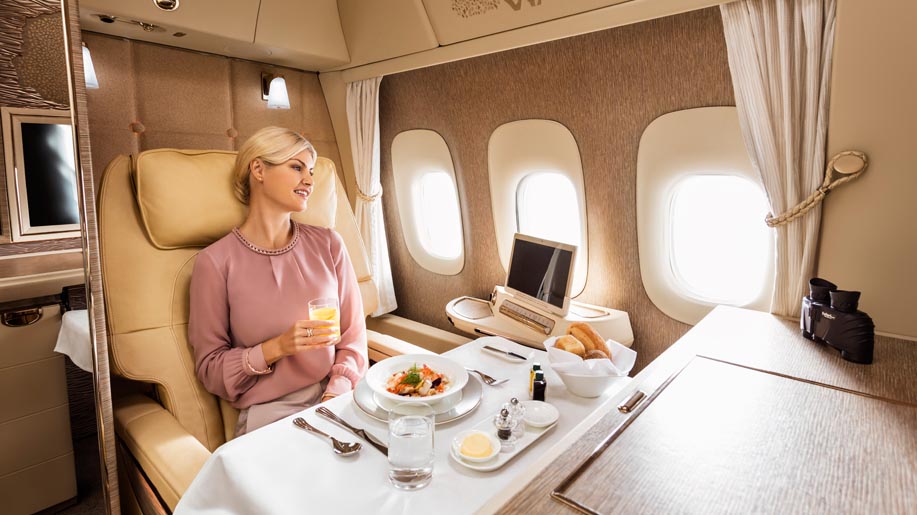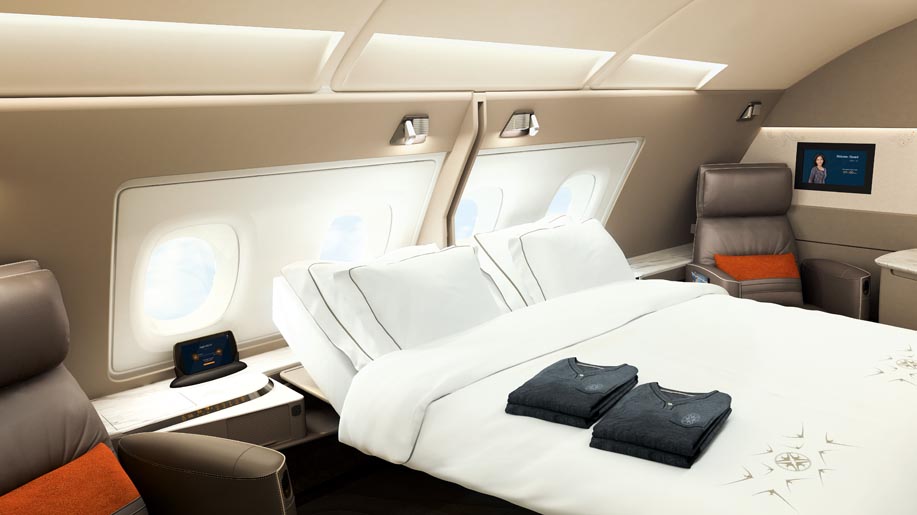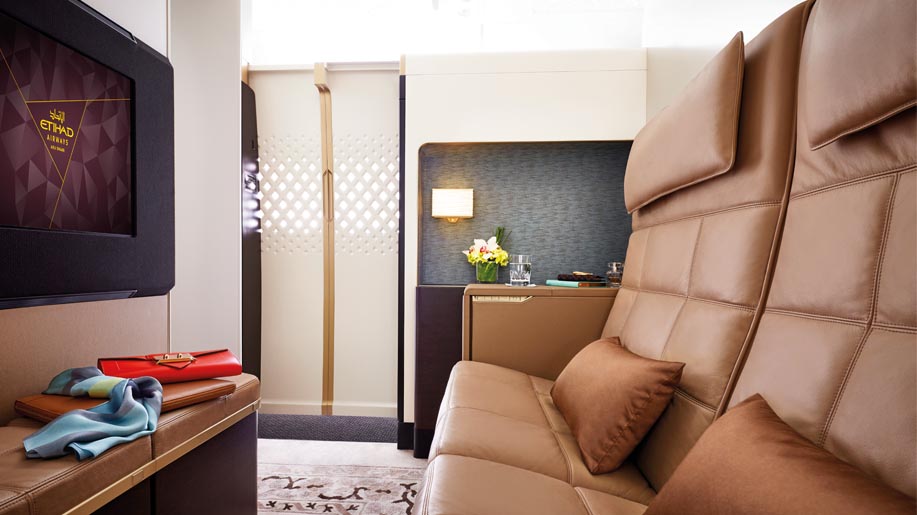
The world watched in awe as Etihad took bookings for its luxurious Residence. This is something we had never seen before and it really changes the way people travel,” says Vishal Jolapara, one of India’s leading aviation photographers and bloggers.
In 2015, Abu Dhabi-based Etihad Airways made headlines when it announced the “Residence” a penthouse in the sky, with a separate sitting room, a bedroom with a double bed and a separate bathroom. During a recent visit to the Etihad Airways Innovation Centre in Abu Dhabi, the airline’s product team highlighted that these premium cabins are not designed to look like a typical first or business class product. They’re modelled after a “private member’s club” or even a yacht. And further adding to the luxury quotient are exclusive privileges like a private Savoy-trained butler, branded amenities, luxurious linen, massive television screens and the works. This is the super first class.
In aviation parlance, the super first class is a product that goes beyond the traditional first class. The more conventional first class products do not involve enclosed suites, but wide flat-bed seats, albeit with limited privacy.
There has been an ongoing debate about the relevance of first class since 2017, because of the sufficiency of new, enhanced business class seats, as well as the introduction of premium economy cabins. Despite this, most long-haul airlines – Cathay Pacific, British Airways, Lufthansa, Air India, Jet Airways – continue to offer a noteworthy first class product on their long-haul routes, catering to a small bunch of travellers who are looking for that extra exclusivity.
And then there are the following four, including Etihad, who cater to an even smaller group with their offerings that come at a dear price.

Revisiting History
In 2007, Singapore Airlines rolled out its new Airbus 380, pegged to be its flagship aircraft. The highlight of this was its revolutionary offering of 12 self-contained luxurious suites. This was in addition to its existing first class product (not present on the A380, but on the B777), making it the first airline to offer a cabin product above first class. It also became the first airline in the world to offer a double bed in the sky, with their only two centre suites being designed in this way. It was a truly revolutionary product and marked the new age of luxe travel at the time, in a relatively unpredictable economic climate.
Soon after, and before Etihad launched the Residences, Dubai-based Emirates rolled out its plush Airbus 380s. It made the news with its first class product – once again, self-contained suites, but with single beds. However, this time the highlight of the super first class was the shower in the sky. The bathrooms in this cabin, christened Shower Spa, allow passengers to take a shower during the course of a flight.
Interestingly enough, Doha-based Qatar Airways offers a first class only on its A380 aircraft. However, this cabin is not designed in a suites format. The airline has decided to concentrate on its “super business class” instead, which has been rolled out on the A350 and B777. Qatar Airways CEO Akbar Al Baker told me, “our business class is so good that it can be counted as a first class product. We will go all out to make our business class product as revolutionary as possible.” Qatar’s new Qsuite business class product is designed such that four people can travel, dine and interact together in the same suite. Many would agree that this is a great innovation for premium travellers.
Jason Rabinowitz, the director of airline research at Routehappy and an aviation influencer says, “While many airlines are eliminating their first class cabins, a select few are pushing the limits of what is possible with the highly sought-after cabins. There is no clear “right thing” for airlines across the board as each has its own unique identity, customers and standards. In certain markets, first class may be in high demand by passengers, while there may be no demand at all in others. Airlines do extensive market research to justify the need to continue to offer new products or update their first class products, as these are multi-million dollar investments that will take years to recoup.
Having said that, the line between a superior business class product and a first class product has become increasingly blurred in recent years. A select few airlines offer over-the-top, multi-room suites to create a sort of super first class. But that is only possible on the largest of aircraft. There is only so much an airline can do to enhance its first class offering in the sky; so much attention has been shifted to ground handling and services, as a way to separate it from business class.”

What’s New?
To mark the tenth anniversary of its Suites product, Singapore Airlines unveiled its “new” Suite, to be retrofitted on its A380 aircraft. Singapore Airlines CEO Goh Choon Pong says, “When we put the world’s first A380 into commercial service in 2007, it set new industry benchmarks for premium full-service air travel. A decade later, the new A380 product is shining with our flagship products and legendary service.” Be that as it may, the airline’s massive facelift includes a single-aisle Suites cabin featuring six Suites (down from 12), each of which has a separate sitting area (a swivel armchair) and a deployable bed right next to it. The beds in some interconnected Suites can be joined to make a double bed, with a lowered partition. All this is designed in an understated aesthetic by Paris-based Pierrejean Design Studio.
Marvin Tan, the senior VP of product and services at Singapore Airlines adds, “The demand is still there for first class. There is a niche of super wealthy travellers who want to travel their way. Even though an airline may have a fabulous business class product, there is still a significant difference that is fairly tangible between the two cabin classes. Customers who think about what they are willing to pay and the value that they get, will see these two propositions in a very different light. Therefore this would appeal to two very different kinds of customers.” The most significant difference between business and first on Singapore Airlines is the enclosed “Suite” design on the latter.
Emirates, on the other hand, recently gave a facelift to its Boeing 777 first class product with its completely enclosed suites. The cabin is sized down to six suites in a 1-1-1 configuration, each suite spread across 40 square feet with floor-to-ceiling sliding doors. Centre suites that would normally have no window view, have a virtual window with live images being flashed on this window through cameras outside. The bed is designed such that it gives a feeling of weightlessness and the airline goes as far as to offer “moisturising pyjamas” to its guests in addition to the Bulgari amenities.
Paul Thompson, a freelance aviation journalist based in Denver, Colorado doesn’t see this situation as such a rosy picture after all. He says that from a passenger’s perspective, “the fancier the better. As someone who follows the aviation industry closely, I see these enhancements as a series of one-upmanship between these carriers. While it is great to see any airline enhance their product, I think we’re approaching the realm of the absurd. I am not sure there is a sizeable enough niche of passengers who really need these ultra-luxe products.” In the same breath he reasons out, “Nevertheless, for an airline, the advantage of these products is in marketing and being able to say “our cabin is the most luxurious”. Everyone who gets to fly in such a special seat with a butler service is going to share the experience with their social media audience, creating even more publicity for the airline. For their frequent flyers, it gives a visual attainable goal for a once-in-a-lifetime trip.”
There is also the disadvantage of potentially flying with these seats unsold. These seats take up a lot of valuable space in the cabin and are very heavy. Unsold first class seats cause a big loss of revenue for the flight if you consider they could have sold more economy or premium economy seats in their place. In 2018, it is difficult to know if these products actually work or not, from a sustainability point of view. They excite people when they debut, but the chances of most of us actually flying in these suites are almost zero because of the prohibitive pricing.

Suite Products
Emirates First Class
- Aircraft: Boeing 777
- Configuration: Six suites in a 1-1-1 configuration.
- Seat: Each suite measures 40 square feet and is completely enclosed with floor-to-ceiling sliding doors. The flat-bed seat is upholstered in plush leather, and the suite features high-tech control panels, mood lighting and even a video calling facility so you can talk to your crew from your suite.
- Perks: Emirates’ brilliant First Class Lounge at Dubai airport, Mercedes-Benz S-Class transfers, Bowers and Wilkins headphones, Bulgari amenity kits and moisturising pyjamas
- Route: Currently operating on the Dubai-Brussels route.
- Price: US$5,000/₹3,24,825 one way for the above route in April.
Etihad Airways The Residence
- Aircraft: Airbus 380
- Configuration: One single Residence.
- Seat: The Residence features three-rooms — a living room, a bedroom with a double bed and an attached bathroom. The living room features a double seat sofa and two dining tables. The bedroom features a full-size double bed with a 27-inch flat screen television and the bathroom has a shower, hairdryer and vanity unit.
- Perks: A Savoy-trained butler to attend to you and personalised dining, courtesy the in-flight chef. Other perks include full-sized amenity products, private lounges and limousine transfers.
- Route: Currently operating on the Abu Dhabi-New York route.
- Price: US$22,500/₹14,617,712 one way for the above route in April.
Singapore Airlines Suites
- Aircraft: Airbus 380
- Configuration: Six Suites on either side of one single aisle.
- Seat: The Suite features two separate areas — a swivel armchair and a deployable bed. Certain Suites can be converted into a double bed format by lowering the partition. Seats are upholstered in Poltrona Frau leather.
- Perks: 32-inch flat screen television, plush carpet, full-sized wardrobe, amenity box and stowage compartment. Lalique has designed the amenity kit as well as the plush linen, best enjoyed after the turndown service.
- Route: Currently operating on the Singapore-Sydney route.
- Price: US$4,057/₹2,63,563 one way for the above route in April.
Qatar Airways Qsuite Business Class
- Aircraft: Airbus 350 and Boeing 777
- Configuration: 42 seats in a 1-2-1 layout. All seats have aisle access. The Qsuites comprise four seats in a forward-backward facing layout, which can be opened up by lowering the dividers. Ideal for a family of four, or four colleagues, travelling together.
- Seat: The Qsuite seat features a sliding door for increased privacy, a feature usually seen in first class. The spacious lie-flat bed is upholstered in hand-stitched Italian leather,
- Perks: The Qsuite offers a host of other perks like a massive screen, a touchscreen control panel, power points for your gadgets and lots of stowage space. The dine-on-demand service is an added benefit and Qatar Airways’ extensive wine list only makes it better.
- Route: Currently operating on the Doha-Paris Charles de Gaulle route.
- Price: US$4,500/₹2,92,342 one way for the above route in April.
Riaan Jacob George












